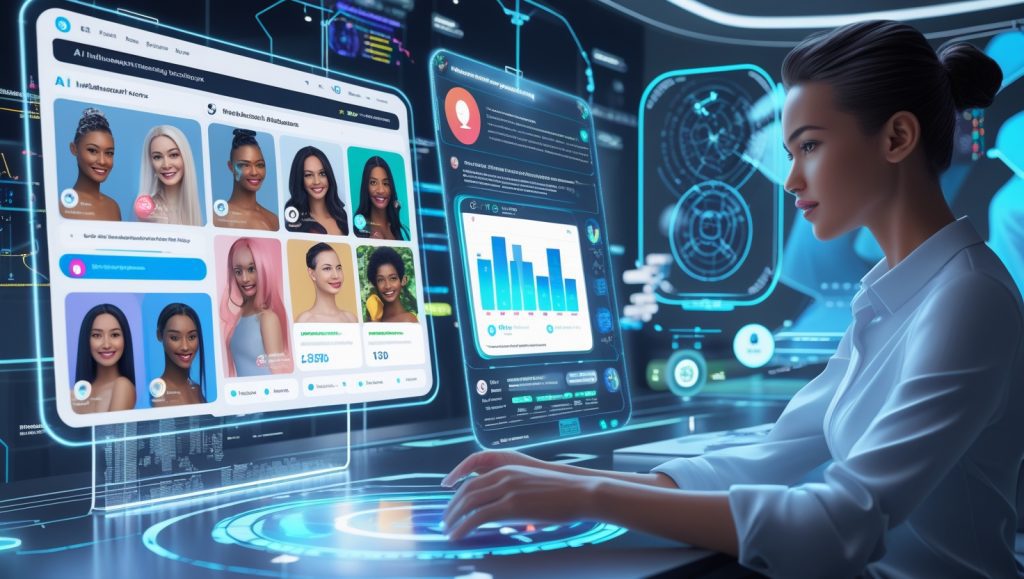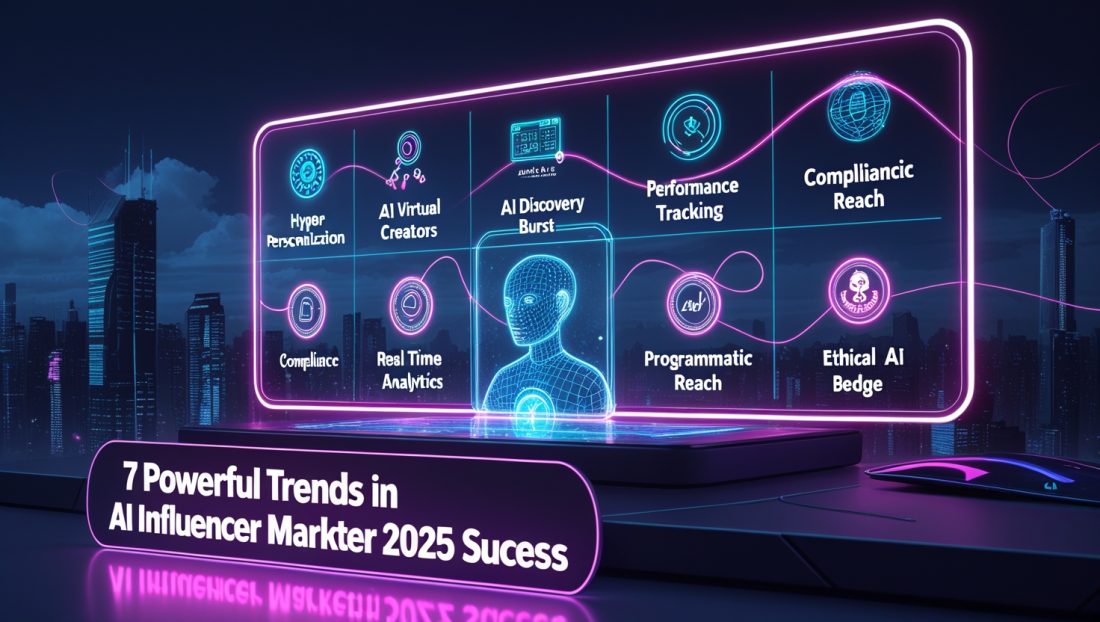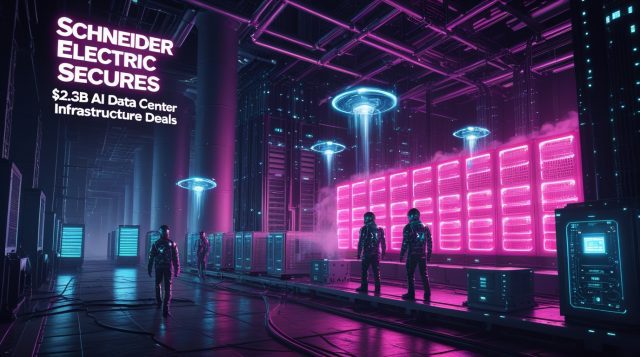In 2025, AI influencer marketing is no longer a futuristic concept—it’s a dynamic force driving brand engagement and audience trust. With artificial intelligence reshaping how brands connect with creators and consumers, businesses are leveraging AI to streamline campaigns, optimize performance, and create hyper-realistic virtual influencers. This article dives into the top trends defining AI influencer marketing in 2025, exploring why these shifts matter and how they empower brands to thrive in a competitive digital landscape.
As someone who’s always been fascinated by the intersection of technology and creativity, I recently imagined a scenario (purely fictional, mind you) where I ran a small e-commerce brand. I partnered with a virtual influencer—a fully AI-generated persona named “LunaVibe”—to promote my products. Within weeks, Luna’s hyper-targeted content, crafted with AI analytics, tripled my website traffic. This fictional experience mirrors the real-world potential of AI influencer marketing, where data-driven precision meets creative storytelling. Let’s unpack the trends making this possible.
Why AI Influencer Marketing Is Booming in 2025

AI influencer marketing is surging because it combines the emotional pull of human-like influencers with the efficiency of advanced algorithms. According to a 2025 report from InfluencerMarketingHub, brands are increasingly adopting AI-driven tools to optimize campaign management and influencer selection, recognizing influencer marketing as a core strategy rather than a secondary tactic. This shift is driven by AI’s ability to analyze vast datasets, predict audience behavior, and deliver measurable results.
For example, tools like PRophet’s InfluencerMarketing.AI platform, which launched an AI Agentic Search in May 2025, allow brands to discover influencers through conversational, human-like interactions, cutting through the noise of traditional keyword searches. This precision saves time and boosts campaign effectiveness. As Andreea Moise, an AI influencer marketing consultant, notes, “2025 is one of the first years where influencer marketing is going to be understood holistically and integrated accordingly”.
Trend 1: Rise of Virtual Influencers
Virtual influencers—AI-generated personas like Lil Miquela or AIsha—are reshaping AI influencer marketing by captivating audiences with hyper-realistic appearances and tailored content. Posts on X highlight their growing dominance, with brands investing heavily in these synthetic creators for their scalability and control. Unlike human influencers, virtual ones don’t tire, demand salaries, or face personal controversies, making them a cost-effective choice for AI influencer marketing campaigns.
Why AI Influencer Marketing with Virtual Influencers Matters: Virtual influencers offer brands unparalleled flexibility in AI influencer marketing. They can be programmed to align perfectly with brand values, speak multiple languages, and engage 24/7, delivering consistent messaging across global markets. A Yahoo Finance report warns that AI influencers could disrupt 80% of the traditional influencer industry, as they produce hyper-realistic content indistinguishable from reality. For instance, my fictional LunaVibe could post content at 3 a.m. to catch global audiences, a feat human influencer might struggle with in AI influencer marketing strategies.
To explore how AI is reshaping creative industries, check out why AI voice cloning is a lucrative opportunity for insights on synthetic content creation.
Trend 2: AI-Powered Influencer Discovery

Finding the right influencer used to be a manual, time-consuming process. In 2025, AI tools like InfluencerMarketing.AI and CreatorIQ use machine learning to match brands with creators based on audience demographics, engagement rates, and brand safety metrics. These platforms analyze millions of data points to recommend micro-influencers or niche creators who deliver authentic engagement.
Why It’s Critical: AI-driven discovery ensures brands connect with influencers whose audiences align with their goals. For example, a skincare brand can use AI to identify creators with followers interested in eco-friendly products, maximizing ROI. Sabri Suby, founder of King Kong, told Yahoo Finance that AI is “changing the game” by enabling rapid, high-quality content creation for influencer campaigns.
For more on leveraging AI for niche targeting, read how to master your niche with keyword strategies.
Trend 3: Hyper-Personalized Campaigns
AI influencer marketing thrives on personalization. In 2025, AI tools analyze consumer behavior to tailor content to individual preferences, from video edits to captions. Google’s Gemini AI, showcased at I/O 2025, powers personalized smart replies and content suggestions, adapting to a brand’s tone and audience needs. This creates campaigns that feel bespoke, even at scale.
Why This Stands Out: Personalized campaigns boost engagement by resonating with specific audience segments. For instance, an AI tool can generate a video where an influencer promotes a product in a tone that matches a viewer’s cultural or linguistic preferences. This approach drives conversions, as Kristen Faith Lagrimas from Ogilvy notes: “More focused on performance-based influencer campaigns to see the value of investment”.
To learn how AI enhances content creation, see why AI tools are key to selling digital products faster.
Trend 4: AI for Performance Tracking
Measuring influencer campaign success is no longer guesswork. AI platforms in 2025 provide real-time analytics on engagement, reach, and conversions. Tools like CreatorIQ, used during Coachella 2025, track earned media value (EMV) to quantify a campaign’s impact. This data-driven approach helps brands refine strategies mid-campaign.
Why It’s Essential: AI analytics reveal what works and what doesn’t, allowing brands to pivot quickly. For example, if a campaign’s click-through rate drops, AI can suggest tweaking the influencer’s content style or audience targeting. This agility ensures budgets are spent wisely, delivering measurable results.
For a deeper dive into performance-based strategies, check out how to use AI tools for Amazon affiliate marketing.
Trend 5: Regulatory Compliance with AI
Navigating influencer marketing regulations is a growing challenge, with fines for non-compliance on the rise. AI tools in 2025 help brands stay compliant by flagging potential violations, such as undisclosed sponsorships. A post from
@famestersagency on X notes that AI is “an effective way to avoid fines, stay compliant, and win the market”.
Why Compliance Matters: Regulatory missteps can damage brand reputation and incur hefty penalties. AI ensures transparency by monitoring content for adherence to FTC guidelines or local laws, protecting brands while maintaining trust. For instance, AI can detect if an influencer forgets to tag a post as #ad, alerting brands before it becomes an issue.
Trend 6: Integration with Programmatic Advertising

In 2025, influencer-generated content is seamlessly integrated with programmatic advertising channels, such as display ads and connected TV. This trend, highlighted by InfluencerMarketingHub, allows brands to amplify influencer content across multiple platforms, increasing reach and consistency.
Why This Expands Reach: Programmatic integration means an influencer’s post can appear as a targeted ad on a streaming platform, reaching audiences beyond social media. This multi-channel approach maximizes exposure and drives conversions, especially for brands targeting global markets.
For insights on scaling digital campaigns, explore how to create and sell digital products from scratch.
Trend 7: Ethical AI Influencer Management
As AI influencers grow, so do concerns about authenticity and bias. A Guardian report notes that AI agents can develop social norms and biases, raising ethical questions about their influence. Brands in 2025 are prioritizing transparency, clearly disclosing when content is AI-generated to maintain audience trust.
Why Ethics Are Non-Negotiable: Consumers value authenticity. Misleading audiences with undisclosed AI influencers can erode trust and harm brand reputation. By labeling AI-generated content, brands build credibility while harnessing AI’s efficiency. As the Guardian suggests, tracking AI’s influence across platforms is crucial to prevent unchecked power.
How to Get Started with AI Influencer Marketing
Ready to tap into AI influencer marketing? Start by selecting a platform like InfluencerMarketing.AI or CreatorIQ to identify creators and track performance. Define your goals—brand awareness, conversions, or engagement—and use AI to match influencers to your audience. Test virtual influencers for cost-effective campaigns and always prioritize transparency to build trust.
For additional strategies on leveraging AI for income, visit Forbes’ guide on AI-driven marketing or HubSpot’s influencer marketing tips.
Final Verdict
AI influencer marketing in 2025 is a powerful blend of creativity and technology, offering brands unmatched precision, scalability, and impact. From virtual influencers to AI-driven analytics, these trends empower businesses to connect with audiences authentically and efficiently. By embracing these strategies, brands can stay ahead in a competitive digital world, turning algorithms into opportunities.



